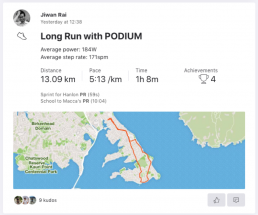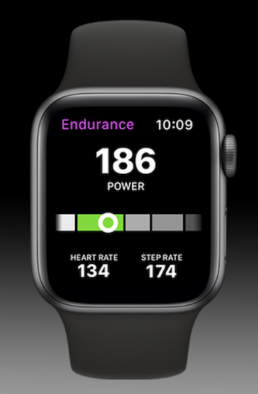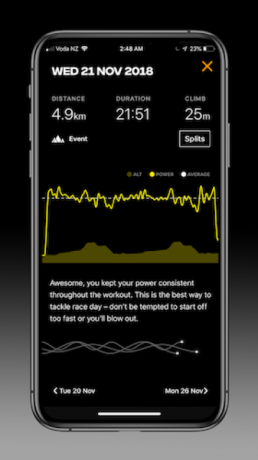A huge part of training for an event — whether it’s your first 10K or your 5th marathon — is having the right metrics to guide your performance. PODIUM, our new running app, has important running metrics like speed/pace (min/km or min/mi) and heart rate…but it also has a groundbreaking new metric: Power, measured in watts. (e.g. 124w)
Why is Power important for running?
1 — With Power, you’ll always know what the right effort is
During your longer runs, you would normally try to run evenly throughout the run. You might be used to Speed or Pace as the metric for this. The problem is that hills mess this up!
As you run up the hill, your speed slows down making it difficult to clearly know the correct pace to keep things even.
Power as a metric takes gradient into account so you can evenly run at say 200 watts no matter what the terrain.

2 — You’ll be able to stay in control of your performance
The sports world has been very ‘lungs’ (cardiorespiratory) orientated in the last few decades with heart rate measurement dominating. If I asked you what the limiting factor was in say a half marathon, leg fatigue or lungs fatigue, what would you say? Most people say legs. Heart rate doesn’t tell you much about your legs. Heart rate just rises as you get tired. Speed doesn’t help much either. It doesn’t highlight what fatigues your legs.
But power does. As most people run up hills, their power spikes (running on: flat = 200w, hill = 290w). Think of each power spike as a match being struck from a box of matches. There is a point where you’ve burnt so many matches that you run out. That’s when your legs ‘give out’.
With power you learn how to control the factor that limits your performance in an event.
PODIUM also happens to be able to automatically learn your personal training effort zones from past runs as power zones! (along with sensing your pace zones) This means that after a few runs, you have an easy-to-read ‘power effort gauge’ allowing you to manage effort on any terrain.

3 — You can get immediate feedback
Doing speed work with heart rate can be troublesome because there is a lag between when you initiate the higher speed and when your heart rate finally stabilises to correctly define the effort. This can take between 30 seconds and 90 seconds.
Because of the discomfort of speed training, 30 to 90 seconds is a long time in the ‘pain locker’ while you are waiting to see if you have the right effort dialled in. Less experienced runners often overshoot the correct effort, running too hard.
When using running power, you just dial in the correct effort and get immediate feedback. No delay, no uncertainty.
4 — Power is terrain agnostic
Preparing for an event often involves simulating the correct effort. For example, running 10km in 60 minutes means 6min/km (9min 42s/mi) pace. Using heart rate as your simulation metric is problematic because it fluctuates daily (higher HR some days and lower HR others to achieve the same simulation speed) which doesn’t clearly define the 6min/km (9min 42s/mi) required to simulate your target. Speed and power are much better for simulating race pace and as already discussed, unlike speed, power has the advantage that it can be used on any terrain.
5 — Power provides more insights
Finally, the other advantage to your training is understanding the relationship between your actions and your body’s reaction to exercise. Ideally you initiate an action (running at a power) and your body demonstrates a reaction (heart rate changes).
This tells you how your body is responding to your training. Using power to measure the action and heart rate to measure the reaction, a whole lot of other useful insights open up to tell you how your training is going. But that is a story for another day…. 😊

Notes: Running Power can be thought about in different ways. For example, it could take into account the braking effort with each foot strike or the degree of ‘bounce’ with each stride. All these additions can legitimately be put into the power value.
But do most of us need this?
As runners ourselves, we find these high power numbers understandably don’t match our cycling wattage which feels disconcerting. This is because cycling power is a propulsive power measurement so we chose to make our running power propulsive to match.
This means more consistent values between the bike and the run if you’re a triathlete. It also acts more like an effort measure, which helps with pacing and doesn’t require an external device. We wanted everyone to have access to the revolution. Try it, once you get used to it, you’ll love it.
Try PODIUM for free and let us know what you think! Available for iOS now from the app store.